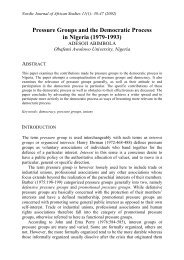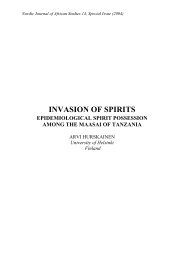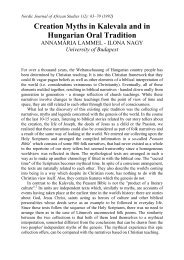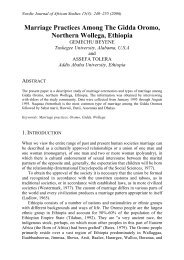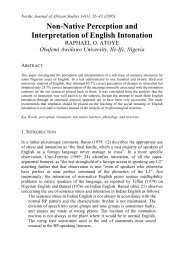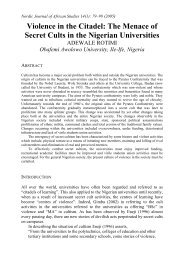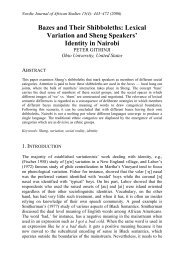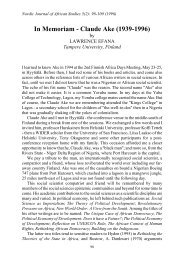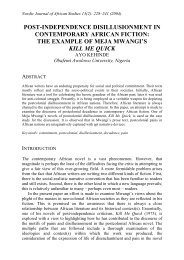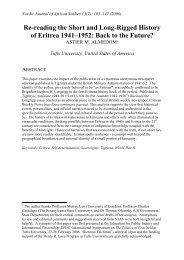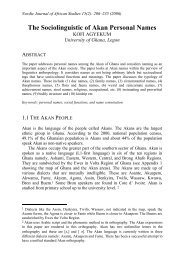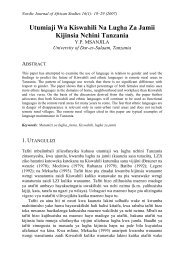intertextuality and the contemporary african novel - Nordic Journal of ...
intertextuality and the contemporary african novel - Nordic Journal of ...
intertextuality and the contemporary african novel - Nordic Journal of ...
Create successful ePaper yourself
Turn your PDF publications into a flip-book with our unique Google optimized e-Paper software.
<strong>Nordic</strong> <strong>Journal</strong> <strong>of</strong> African Studies 12(3): 372–386 (2003)<br />
ABSTRACT<br />
INTERTEXTUALITY AND THE<br />
CONTEMPORARY AFRICAN NOVEL<br />
AYO KEHINDE<br />
Obafemi Awolowo University, Nigeria<br />
Many critical <strong>the</strong>ories have evolved as a result <strong>of</strong> <strong>the</strong> pluralistic nature <strong>of</strong> <strong>the</strong> <strong>contemporary</strong><br />
world. There is a diversion away from <strong>the</strong> monolithic <strong>the</strong>ories to more synchronic ones. One<br />
<strong>of</strong> such <strong>the</strong>ories that have been at <strong>the</strong> heart <strong>of</strong> this strain is <strong>intertextuality</strong>. The relevance <strong>of</strong><br />
Intertextuality to <strong>the</strong> analysis <strong>of</strong> <strong>contemporary</strong> African Drama has been widely discussed.<br />
However, <strong>the</strong>re is a dearth <strong>of</strong> studies on <strong>the</strong> place <strong>of</strong> <strong>the</strong> <strong>the</strong>ory in <strong>the</strong> production <strong>and</strong> criticism<br />
<strong>of</strong> <strong>contemporary</strong> African fiction. This paper seeks to partake in <strong>the</strong> filling <strong>of</strong> this critical gap.<br />
Therefore, in <strong>the</strong> paper, an attempt is made to do a critical examination <strong>of</strong> <strong>the</strong> relevance <strong>of</strong><br />
<strong>intertextuality</strong> to <strong>the</strong> evaluation <strong>of</strong> <strong>the</strong> <strong>contemporary</strong> African <strong>novel</strong>. It is discovered that<br />
<strong>intertextuality</strong> appears relevant to <strong>the</strong> production <strong>and</strong> criticism <strong>of</strong> <strong>the</strong> <strong>contemporary</strong> African<br />
<strong>novel</strong>. However, we hasten to declare, from <strong>the</strong> outset, that a single paper would be<br />
inadequate to explicate <strong>the</strong> practice <strong>of</strong> <strong>intertextuality</strong> in African prose fiction; we <strong>the</strong>refore<br />
limit ourselves to a representative sample <strong>of</strong> related <strong>contemporary</strong> African prose texts.<br />
Keywords: <strong>intertextuality</strong>, African, <strong>novel</strong>, <strong>the</strong>ory, <strong>contemporary</strong>.<br />
About <strong>the</strong> author: Dr Ayo Kehinde teaches African Literature (oral <strong>and</strong> written), New<br />
Literature in English <strong>and</strong> Literary Theory at <strong>the</strong> Obafemi Awolowo University, Ile-Ife,<br />
Nigeria. He has published extensively in many reputable international learned journals. He is<br />
an editorial consultant to a few learned journals.<br />
1. INTERTEXTUALITY: ORIGIN AND BASIC TENETS<br />
The concept <strong>of</strong> ‘influence’ was jettisoned in favour <strong>of</strong> <strong>intertextuality</strong> because <strong>of</strong><br />
some inherent flaws in it. In <strong>the</strong> main, influence was considered to be authorcentered<br />
<strong>and</strong> evaluative. It was <strong>the</strong>refore an important tool for subjective literary<br />
historians. Thus, because <strong>of</strong> its excessive emphasis on authorship, <strong>the</strong> concept <strong>of</strong><br />
influence gave way to <strong>intertextuality</strong>. However, <strong>the</strong> shift from influence to<br />
<strong>intertextuality</strong> does not totally bracket <strong>of</strong>f <strong>the</strong> author-centered criticism; ra<strong>the</strong>r, it<br />
aims at broadening it to take into account <strong>the</strong> multifarious relations that can exist<br />
among authors.<br />
By <strong>the</strong> mid-to-late 1960s, <strong>the</strong> <strong>the</strong>ory <strong>of</strong> <strong>intertextuality</strong> emerged. The basic<br />
tenets <strong>of</strong> <strong>the</strong> <strong>the</strong>ory were first elaborated in Northrop Frye’s Anatomy <strong>of</strong><br />
Criticism. Frye sees literature as an entity containing life <strong>and</strong> reality in a system<br />
<strong>of</strong> verbal relationships. He also maintains that <strong>intertextuality</strong> “subsumes <strong>the</strong>
Intertextuality <strong>and</strong> <strong>the</strong> Contemporary African Novel<br />
work <strong>of</strong> ‘major’ authors with that <strong>of</strong> ‘minor’ figures in a multiple positional<br />
typology based on relation <strong>and</strong> difference” (quoted from Clayton <strong>and</strong> Rothstein,<br />
1991: 17).<br />
Ano<strong>the</strong>r key proponent <strong>of</strong> <strong>the</strong> <strong>the</strong>ory <strong>of</strong> <strong>intertextuality</strong> is Julia Kristeva. In<br />
fact, <strong>the</strong> nomenclature “<strong>intertextuality</strong>” is her coinage. She initially used <strong>the</strong><br />
term in her dialogue with <strong>the</strong> texts <strong>of</strong> Mikhail Bakhtin. Moreover, Kristeva gives<br />
several illuminating definitions <strong>of</strong> <strong>intertextuality</strong>, among which are <strong>the</strong><br />
following:<br />
Any text is constructed as a mosaic <strong>of</strong> quotations; any text is <strong>the</strong><br />
absorption <strong>and</strong> transformation <strong>of</strong> ano<strong>the</strong>r (quoted from Clayton <strong>and</strong><br />
Rothstein, 1991: 20).<br />
In <strong>the</strong> space <strong>of</strong> a given text, several utterances, taken from o<strong>the</strong>r texts,<br />
intersect <strong>and</strong> neutralize one ano<strong>the</strong>r (Clayton <strong>and</strong> Rothstein, 1991: 29).<br />
It is <strong>the</strong>refore <strong>the</strong> contention <strong>of</strong> Kristeva that <strong>intertextuality</strong> is an instance<br />
whereby a text depicts a reading <strong>of</strong> <strong>the</strong> anterior literary corpus, <strong>the</strong>reby making<br />
text absorption <strong>of</strong> <strong>and</strong> a reply to ano<strong>the</strong>r text. The <strong>intertextuality</strong> <strong>the</strong>orist<br />
believes that <strong>the</strong> only reader is <strong>the</strong> writer reading ano<strong>the</strong>r text, a figure that<br />
becomes no more than a text re-reading itself as it re-writes itself.<br />
It should be stressed that <strong>the</strong> metaphor <strong>of</strong> creation has traditionally<br />
dominated discussions <strong>of</strong> literary authorship, with a strong implication <strong>of</strong> <strong>the</strong><br />
mysterious, possibly transcendental nature <strong>of</strong> such activities. According to<br />
Leitch (1983: 123):<br />
When it finds its way into a current text, a chip or piece <strong>of</strong> an older<br />
monument appears as source, influence, allusion, imitation, archetype or<br />
parody.<br />
Although <strong>the</strong> foregoing description <strong>of</strong> <strong>intertextuality</strong> (by Leitch) appears<br />
obsolete, it is still relevant to an underst<strong>and</strong>ing <strong>of</strong> <strong>the</strong> origins <strong>and</strong> tenets <strong>of</strong> <strong>the</strong><br />
<strong>the</strong>ory. Like Leitch, Terry Eagleton (1983: 192) observes that all literary works<br />
are to some extent “rewritten”, although this may be an unconscious practice <strong>of</strong><br />
<strong>the</strong> societies that read <strong>the</strong>m. Eagleton <strong>the</strong>refore concludes that <strong>the</strong>re is no<br />
reading <strong>of</strong> a work that is not a re-writing. This is based on <strong>the</strong> concept <strong>of</strong><br />
transmission. Intertextuality may <strong>the</strong>refore be seen as <strong>the</strong> enlargement <strong>of</strong> a<br />
familiar idea or as an entirely new concept to replace <strong>the</strong> outmoded notion <strong>of</strong><br />
influence. As an enlargement <strong>of</strong> <strong>the</strong> previous concept <strong>of</strong> influence,<br />
<strong>intertextuality</strong> is more general in scope than influence. It has to do with a much<br />
more impersonal field <strong>of</strong> crossing texts. Apart from <strong>the</strong> traditional authorcentered<br />
<strong>the</strong>ories, <strong>the</strong>re are now new <strong>the</strong>ories, which emphasize <strong>the</strong> decline <strong>of</strong><br />
<strong>the</strong> author in <strong>the</strong> concept <strong>of</strong> <strong>intertextuality</strong>. Deconstructive criticism, which<br />
believes that <strong>the</strong> ‘author’ is no more than one text among o<strong>the</strong>rs, is an example.<br />
The author’s life will not provide <strong>the</strong> reader/audience with a firm foundation for<br />
<strong>the</strong> meaning <strong>of</strong> <strong>the</strong> work since <strong>the</strong> text is only available to <strong>the</strong> reader. Rol<strong>and</strong><br />
373
<strong>Nordic</strong> <strong>Journal</strong> <strong>of</strong> African Studies<br />
Bar<strong>the</strong>s, for instance, advances a <strong>the</strong>ory <strong>of</strong> <strong>intertextuality</strong> that depends on <strong>the</strong><br />
reader as <strong>the</strong> organizing center <strong>of</strong> interpretation.<br />
Again, for <strong>the</strong> Deconstructionist, <strong>intertextuality</strong> refers to both <strong>the</strong><br />
relationship among literary texts <strong>and</strong> <strong>the</strong> dialogue between <strong>the</strong>m <strong>and</strong> o<strong>the</strong>r<br />
writings. This is akin to <strong>the</strong> view <strong>of</strong> Martin Coyle, et al who maintain that:<br />
Each text takes its meaning from o<strong>the</strong>r texts, not merely prior texts, but<br />
o<strong>the</strong>r concomitant texts <strong>and</strong> expressions <strong>of</strong> culture <strong>and</strong> language. The<br />
blank <strong>and</strong> marble pages, <strong>the</strong> squiggly lines, <strong>the</strong> scrampled chapters, <strong>the</strong><br />
skipped pages <strong>of</strong> Tristram Sh<strong>and</strong>y are intertextual events because <strong>the</strong>y<br />
respond not only to extant literary texts, but to <strong>contemporary</strong> <strong>and</strong><br />
medieval ideas <strong>of</strong> logic, or order <strong>of</strong> rationality (1990: 613).<br />
In <strong>the</strong> same vein, one <strong>of</strong> <strong>the</strong> crucial tasks <strong>of</strong> <strong>the</strong> postmodernist critic is to<br />
foreground what might be called <strong>the</strong> “intertextual elements” in literary works.<br />
According to Peter Barry (1995: 91), <strong>intertextuality</strong>, in postmodernism, purports<br />
to examine “a major degree <strong>of</strong> reference between one text <strong>and</strong> ano<strong>the</strong>r”.<br />
However, in <strong>the</strong> scrutiny <strong>of</strong> <strong>the</strong> reference, <strong>the</strong> postmodernist critic privileges <strong>the</strong><br />
ab<strong>and</strong>onment <strong>of</strong> <strong>the</strong> divine pretensions <strong>of</strong> authorship.<br />
Perhaps, M. H. Abrams’s definition <strong>of</strong> <strong>intertextuality</strong> provides <strong>the</strong> aptest<br />
framework for this discourse. According to him, <strong>intertextuality</strong> is a creative<br />
means used to:<br />
Signify <strong>the</strong> multiple ways in which any one literary text echoes, or is<br />
inescapably linked to, o<strong>the</strong>r texts, whe<strong>the</strong>r by open or covert citations <strong>and</strong><br />
allusions, or by <strong>the</strong> assimilation <strong>of</strong> <strong>the</strong> feature <strong>of</strong> an earlier text by a later<br />
text, or simply by participation in a common stock <strong>of</strong> literary codes <strong>and</strong><br />
conventions (1981: 200).<br />
2. INTERTEXTUALITY AND AFRICAN LITERATURE:<br />
THEORETICAL ISSUES<br />
The <strong>the</strong>ory <strong>of</strong> <strong>intertextuality</strong>, despite its Euro-western origin, is not entirely alien<br />
to African oral literary practice. In fact, African oral literature, among many<br />
o<strong>the</strong>r features, is marked by its status <strong>of</strong> non-authorship. That is, more <strong>of</strong>ten than<br />
not, oral literary genres in Africa are taken as having no individual authors as is<br />
<strong>the</strong> case <strong>of</strong> written literature. Ra<strong>the</strong>r, oral literature is conceived as a communal<br />
artifact. It is communally owned <strong>and</strong> transmitted from generation to generation.<br />
In <strong>the</strong> words <strong>of</strong> Ruth Finnegan (1970: 36), “such literature was, for instance,<br />
supposed to be <strong>the</strong> work <strong>of</strong> communal consciousness <strong>and</strong> group authorship<br />
ra<strong>the</strong>r than … <strong>of</strong> an individual inspired artist.”<br />
Contemporary African writers are participating in <strong>the</strong> global literary trend <strong>of</strong><br />
<strong>intertextuality</strong> for several reasons, chiefly among which are <strong>the</strong> following. In <strong>the</strong><br />
first instance, <strong>the</strong>re is cultural homogeneity among <strong>the</strong> peoples <strong>of</strong> <strong>the</strong> world; this<br />
calls for writers to model <strong>the</strong>ir works on some precursor works. Again, human<br />
374
Intertextuality <strong>and</strong> <strong>the</strong> Contemporary African Novel<br />
existence revolves in <strong>the</strong> same vicious circle <strong>of</strong> tumult consequent upon bad<br />
leadership <strong>and</strong> o<strong>the</strong>r social <strong>and</strong> ontological ills. Therefore, <strong>the</strong>re are<br />
configurations <strong>and</strong> connections between works <strong>and</strong> writers within <strong>the</strong> different<br />
literary genres (Biodun Jeyifo, 1988: 277). Literature does not evolve within a<br />
vacuum. It depends on <strong>the</strong> socio-political realities <strong>of</strong> its enabling milieu <strong>and</strong> <strong>the</strong><br />
precursor texts (oral/written) for its impetus. Thus, for <strong>the</strong> proponents <strong>of</strong><br />
<strong>intertextuality</strong> literature evolves from literature. African writers also depend on<br />
earlier texts for <strong>the</strong>ir <strong>the</strong>mes <strong>and</strong> styles. This is quite pertinent in this era <strong>of</strong><br />
multiculturalism <strong>and</strong> globalization.<br />
Commenting on <strong>the</strong> relevance <strong>of</strong> <strong>intertextuality</strong> to African literature, Dan<br />
Izevbaye (1982: 1) asserts that it is a veritable weapon in <strong>the</strong> h<strong>and</strong>s <strong>of</strong> literary<br />
historians <strong>and</strong> critics to “establish a relationship among a variety <strong>of</strong> writers <strong>and</strong><br />
literatures, <strong>and</strong> help enhance… underst<strong>and</strong>ing <strong>of</strong> literature as a human activity<br />
with similar aes<strong>the</strong>tic <strong>and</strong> social functions in different cultures”. Therefore,<br />
<strong>intertextuality</strong> is a useful tool for literary historians in discharging <strong>the</strong>ir duty as<br />
recorders <strong>of</strong> critical happenings in literary epochs. Since “each literature or text<br />
has <strong>the</strong> capacity to influence <strong>and</strong> extend <strong>the</strong> meaning <strong>of</strong> <strong>the</strong> o<strong>the</strong>r (Charles<br />
Bodunde, 1994: 72), it is relevant for literary historians to investigate <strong>and</strong><br />
document how texts have reciprocally influenced <strong>and</strong> extended <strong>the</strong>ir meanings.<br />
This is with a view to discovering <strong>the</strong> <strong>the</strong>matic <strong>and</strong> stylistic preoccupations that<br />
are common to world writers in general.<br />
Intertextuality is also an effective postcolonial weapon used to reject <strong>the</strong><br />
claim <strong>of</strong> universalism made on behalf <strong>of</strong> canonical Western literature. The<br />
<strong>the</strong>ory is employed by critics <strong>and</strong> historians to examine <strong>the</strong> issues <strong>of</strong> cultural<br />
difference <strong>and</strong> diversity in literature. The historical circumstances <strong>of</strong> slavery,<br />
colonialism <strong>and</strong> imperialism have made <strong>the</strong> African people experience cultural<br />
hybridity or cultural polyvalency. That is, <strong>the</strong>y mostly belong simultaneously to<br />
more than one culture. Firstly, <strong>the</strong>re is <strong>the</strong> culture <strong>of</strong> <strong>the</strong> colonizer (Euro-<br />
Western culture), which <strong>the</strong> people imbibed through a colonial school system,<br />
religion, mass media <strong>and</strong> <strong>the</strong> like. Secondly, <strong>the</strong>re is <strong>the</strong> o<strong>the</strong>r culture, that <strong>of</strong> <strong>the</strong><br />
colonized - <strong>the</strong> Africans’ own culture, which <strong>the</strong>y acquire through local or oral<br />
traditions.<br />
The <strong>novel</strong> is an imported genre in Africa. It is a twentieth-century<br />
phenomenon, a late arrival on <strong>the</strong> African literary scene. It undeniably trailed<br />
behind <strong>the</strong> two o<strong>the</strong>r literary genres (drama <strong>and</strong> poetry) in evolution. Therefore,<br />
to make it feel at home in an alien l<strong>and</strong>, <strong>contemporary</strong> African <strong>novel</strong>ists rely on<br />
both <strong>the</strong> European model <strong>of</strong> fiction writing <strong>and</strong> <strong>the</strong> autochthonous model <strong>of</strong> oral<br />
narratives: hence <strong>the</strong> glittering amalgam <strong>of</strong> traditional epics, folk traditions,<br />
legends, myths, folktales <strong>and</strong> history <strong>of</strong> <strong>the</strong> people in <strong>the</strong> <strong>contemporary</strong> African<br />
<strong>novel</strong>. Two <strong>of</strong> <strong>the</strong> strategies <strong>of</strong> appropriation in postcolonial writings are cultural<br />
‘revelation’ <strong>and</strong> cultural ‘silence’. While <strong>the</strong> writer ‘reveals’ his<br />
indigenous/autochthonous culture by foregrounding African oral traditions, he<br />
advertently ‘silences’ <strong>the</strong> European methods <strong>of</strong> prose writing by allowing <strong>the</strong><br />
traditional methods <strong>of</strong> oral literature subsume Western techniques.<br />
375
<strong>Nordic</strong> <strong>Journal</strong> <strong>of</strong> African Studies<br />
Consequently, one <strong>of</strong> <strong>the</strong> most important developments <strong>of</strong> <strong>the</strong> <strong>novel</strong> genre in<br />
<strong>contemporary</strong> African literature is how a variety <strong>of</strong> <strong>novel</strong>ists have reappropriated<br />
it to <strong>the</strong>ir own use. Intertextuality is one <strong>of</strong> such indigenizing<br />
strategies <strong>of</strong> <strong>the</strong> <strong>novel</strong>. This is a way <strong>of</strong> upholding <strong>the</strong> syncretic view <strong>of</strong><br />
postcolonial culture that privileges <strong>the</strong> harmonization <strong>of</strong> alterities (Western<br />
culture <strong>and</strong> autochthonous culture). According to J. O. J. Nwachukwu-Agbada,<br />
“<strong>the</strong> Nigerian <strong>novel</strong> is a syn<strong>the</strong>sis <strong>of</strong> foreign <strong>and</strong> local elements in terms <strong>of</strong><br />
characterization, structure, <strong>the</strong>me <strong>and</strong> ideology” (2000: 68). Therefore, in<br />
postcolonial literature, <strong>the</strong> reading <strong>of</strong> a text does not lead to <strong>the</strong> construction <strong>of</strong> a<br />
‘model’ or a ‘structure’, or poetic law, but reveals “fragments, views from o<strong>the</strong>r<br />
texts, codes which disappear <strong>and</strong> mysteriously re-appear” (Lekan Oyegoke,<br />
1992: 158). The fragments are not only from precursor written texts; ra<strong>the</strong>r, <strong>the</strong><br />
African writers also rely on oral texts, that is, <strong>the</strong> oral traditions <strong>of</strong> <strong>the</strong>ir society.<br />
With <strong>intertextuality</strong>, most especially <strong>the</strong> intertextual links between oral <strong>and</strong><br />
written texts, <strong>the</strong> postcolonial writer always participates in his nation’s<br />
decolonization project (literary <strong>and</strong> political).<br />
However, it must be stressed that African literary historians who wish to<br />
make effective <strong>and</strong> objective use <strong>of</strong> <strong>intertextuality</strong> must be familiar with <strong>the</strong><br />
descriptive systems <strong>of</strong> African literature, its <strong>the</strong>mes, its enabling society’s<br />
mythologies <strong>and</strong> its coeval texts. If this is not done, <strong>the</strong> historians will fall victim<br />
to making hasty <strong>and</strong> sweeping overgeneralizations about textual relations <strong>and</strong><br />
awkward influences.<br />
3. INTERTEXTUALITY: THE EXAMPLE OF CONTEMPORARY<br />
AFRICAN FICTION<br />
As a writer, Chinua Achebe sees his primary role as that <strong>of</strong> a ‘teacher’<br />
instructing <strong>the</strong> ignorant about <strong>the</strong> bewildering amalgam <strong>of</strong> African cultures.<br />
Therefore, his fiction established a firmly Afrocentric indigenous basis for<br />
African culture. Also, his initial texts were partly aimed at correcting some<br />
Eurocentric jaundiced stereotypes about Africa <strong>and</strong> Africans. For instance,<br />
Joseph Conrad’s Heart <strong>of</strong> Darkness is full <strong>of</strong> passages highlighting a complex<br />
series <strong>of</strong> evasions, open-eyed blindness, willful forgetfulness, lacunae, egoisms,<br />
<strong>and</strong> <strong>the</strong> like, against Africa <strong>and</strong> her people (Niyi Osundare, 1993: 11). The<br />
constant repetition <strong>of</strong> such words as ‘inscrutable’, ‘incomprehensible’ <strong>and</strong><br />
‘blank’ in Conrad’s text betrays his subjective portrayal <strong>of</strong> African culture <strong>and</strong><br />
people. Although African life is not directly presented in <strong>the</strong> <strong>novel</strong>, Africa, as<br />
<strong>the</strong> setting <strong>of</strong> <strong>the</strong> action <strong>of</strong> <strong>the</strong> <strong>novel</strong> emerges as <strong>the</strong> negation <strong>of</strong> rationality.<br />
Heart <strong>of</strong> Darkness, <strong>the</strong>refore, shows a typical European attitude to Africa,<br />
typical especially in <strong>the</strong> nineteenth <strong>and</strong> early twentieth centuries. To place<br />
African writers in <strong>the</strong> right context, <strong>the</strong> representations <strong>of</strong> European attitudes to<br />
Africa must be kept in view. Thus, most subsequent texts published by African<br />
writers strive at correcting <strong>the</strong> wrong notions about Africa. Ernest Emenyonu<br />
376
Intertextuality <strong>and</strong> <strong>the</strong> Contemporary African Novel<br />
(2002: 2) comments on this: “Things Fall Apart in 1958 began, even when <strong>the</strong><br />
yoke <strong>of</strong> colonialism was still with us, to retell <strong>the</strong> story <strong>of</strong> Africa.”<br />
We can <strong>the</strong>refore posit that texts like Things Fall Apart, Achebe’s wellknown<br />
revisionary reading <strong>of</strong> Conrad’s Heart <strong>of</strong> Darkness, pay attention to <strong>the</strong><br />
gaps, omissions, silences <strong>and</strong> absences perceivable in <strong>the</strong> precursor colonial<br />
texts, which also include Joyce Cary’s Mister Johnson <strong>and</strong> H. Rider Haggard’s<br />
King Solomon’s Mines. Things Fall Apart gives <strong>the</strong> <strong>contemporary</strong> reader a<br />
different perception <strong>of</strong> Africa <strong>and</strong> Africans from that given by Conrad. The<br />
<strong>novel</strong> is usually read as a documentary <strong>of</strong> tribal life. This documentation <strong>of</strong><br />
indigenous values, mores, cultures <strong>and</strong> norms is not fortuitous; ra<strong>the</strong>r, it is<br />
organized to present a society that is ba<strong>the</strong>d in <strong>the</strong> light <strong>of</strong> its own culture. The<br />
rejection <strong>of</strong> “darkness” as <strong>the</strong> defining quality <strong>of</strong> “African experience” is a<br />
relegation <strong>of</strong> <strong>the</strong> power <strong>of</strong> intuition, <strong>the</strong> emotionalism <strong>and</strong> <strong>the</strong> insane laughter in<br />
which Marlow heard <strong>the</strong> thrill <strong>of</strong> primordial appetites. Therefore, <strong>the</strong>re is an<br />
intertextual link between Conrad’s Heart <strong>of</strong> Darkness <strong>and</strong> Achebe’s Things Fall<br />
Apart. They hold each o<strong>the</strong>r in a duel <strong>of</strong> social <strong>and</strong> racial outrage <strong>and</strong> dialogue.<br />
There is also a similar correspondence between some prose works <strong>of</strong> Achebe<br />
<strong>and</strong> <strong>the</strong> works <strong>of</strong> some twentieth-century English writers, most especially<br />
William Butler Yeats. With his leaning on Euro-Western literature, Achebe is<br />
able to retrieve fascinating antecedent works to espouse his philosophical<br />
outlook, i.e., his belief in <strong>the</strong> cyclical <strong>the</strong>ory <strong>of</strong> history. Just as <strong>the</strong> birth <strong>of</strong> Jesus<br />
Christ terminated a 2000-year period <strong>of</strong> history <strong>and</strong> started ano<strong>the</strong>r era, <strong>the</strong><br />
coming <strong>of</strong> Europeans to Africa put an end to precolonial African history <strong>and</strong><br />
inaugurated a new epoch. Thus, in Things Fall Apart, <strong>the</strong>re are snippets from<br />
Yeats’s “The Second Coming.” The <strong>novel</strong> <strong>of</strong> Achebe centers on <strong>the</strong> contact <strong>of</strong><br />
an alien culture with <strong>the</strong> indigenous culture. The latter is heavily crushed <strong>and</strong><br />
bastardized by <strong>the</strong> former. This is <strong>the</strong> significance <strong>of</strong> <strong>the</strong> title <strong>of</strong> <strong>the</strong> <strong>novel</strong><br />
(Things Fall Apart) taken from <strong>the</strong> third verse <strong>of</strong> Yeats’s “The Second Coming”.<br />
Apart from <strong>the</strong>ir intertextual link with precursor written texts, Achebe’s texts<br />
also rely heavily on African (most especially Igbo) folk traditions. He has once<br />
commented on <strong>the</strong> oral <strong>intertextuality</strong> in his written texts: “I have used such<br />
things (oral tradition materials) before, <strong>and</strong> I will use <strong>the</strong>m again. This is what I<br />
have set myself to do: to reconstruct our history through literature (Nwachukwu-<br />
Agbada, 2000: 122). Therefore, in Achebe’s works most especially Things Fall<br />
Apart, <strong>the</strong> reader comes across Igbo Customs, myths, legends, folk tales <strong>and</strong><br />
beliefs in magic, superstition, omens <strong>and</strong> spells. In <strong>the</strong> same <strong>novel</strong>, Achebe<br />
foregrounds some Igbo folktales with a view to deconstructing <strong>the</strong> jaundiced<br />
portrayal <strong>of</strong> African history <strong>and</strong> culture. The folktales include “How <strong>the</strong> Birds<br />
<strong>and</strong> Tortoise were Hosted in Heaven” <strong>and</strong> “The Earth <strong>and</strong> <strong>the</strong> Sky”. These<br />
folktales give <strong>the</strong> African concepts <strong>of</strong> creation, communality <strong>and</strong> diligence.<br />
Also, in Arrow <strong>of</strong> God, Achebe relies heavily on African folk traditions.<br />
There is an intertextual link between <strong>the</strong> <strong>novel</strong> <strong>and</strong> African ritual drama<br />
(Egwugwu - Masquerade), proverbs <strong>and</strong> festival institutions (Akwu Nro). With<br />
<strong>the</strong>se fragments from his cultural environment <strong>and</strong> traditions, Achebe, like many<br />
o<strong>the</strong>r <strong>contemporary</strong> African writers, is able to enrich his creativity. This is a<br />
377
<strong>Nordic</strong> <strong>Journal</strong> <strong>of</strong> African Studies<br />
common attribute <strong>of</strong> many African writers. The attempt to parachute <strong>the</strong> world<br />
<strong>of</strong> folklore <strong>and</strong> mythology into <strong>contemporary</strong> African fiction is a postcolonial<br />
weapon used to foreground <strong>the</strong> richness <strong>of</strong> African culture. Bill Ashcr<strong>of</strong>t, et al<br />
(1989: 64) comment on <strong>the</strong> importance <strong>of</strong> such cultural signifiers in postcolonial<br />
writings: “such devise not only acts to signify <strong>the</strong> difference between cultures<br />
but also illustrates <strong>the</strong> importance <strong>of</strong> discourse in interpreting cultural concepts.”<br />
Achebe exhibits <strong>the</strong> cultural wealth <strong>of</strong> Africans in his <strong>novel</strong>s with a view to<br />
informing foreigners that Africa is not a cultural desert.<br />
Ngugi’s A Grain <strong>of</strong> Wheat also has an apparent intertextual relationship with<br />
Conrad’s Under Western Eyes. The hero <strong>of</strong> Conrad’s text Razumov is a literary<br />
twin-bro<strong>the</strong>r <strong>of</strong> Mugo, <strong>the</strong> anti-hero <strong>of</strong> Ngugi’s A Grain <strong>of</strong> Wheat. Razumov, in<br />
Under Western Eyes, strives courageously to lift himself from poverty <strong>and</strong><br />
obscurity. He <strong>the</strong>refore resents any claims upon him by causes or individuals.<br />
Again, revolutionary colleagues <strong>of</strong>ten mistake his constant alo<strong>of</strong>ness as evidence<br />
<strong>of</strong> his austere dedication to <strong>the</strong> cause.<br />
The young revolutionary hero, Haldin, also visits Razumov immediately<br />
after an undisguised assassination. This is <strong>the</strong> case <strong>of</strong> Mugo who is also visited<br />
by Kihika in Ngugi’s text. As Kihika expresses faith in his taciturn <strong>and</strong><br />
unwilling host (Mugo), so does Haldin express faith in Razumov.<br />
The <strong>the</strong>me <strong>of</strong> betrayal <strong>of</strong> trust, which is central to Ngugi’s concern in A<br />
Grain <strong>of</strong> Wheat, bears certain resemblance to <strong>the</strong> same <strong>the</strong>me treated in<br />
Conrad’s Under Western Eyes. This intertextual <strong>the</strong>matic focus is a means to<br />
comment on some <strong>of</strong> <strong>the</strong> universal problems <strong>of</strong> man, that is, modern man,<br />
irrespective <strong>of</strong> geographical setting, cultural affiliation <strong>and</strong> social status, is a<br />
betrayer.<br />
Ngugi’s A Grain <strong>of</strong> Wheat also has an intertextual link with Conrad’s Lord<br />
Jim. The sense <strong>of</strong> guilt, <strong>the</strong> psychological disposition <strong>of</strong> man under guilt, has a<br />
similar treatment in both <strong>novel</strong>s. Jim’s fate is full <strong>of</strong> guilt, confession <strong>and</strong><br />
expiation. This is akin to <strong>the</strong> experience <strong>of</strong> Mugo after his betrayal <strong>of</strong> Kihika.<br />
The biblical guilty conscience <strong>of</strong> Judas who betrayed Jesus Christ is a common<br />
motif in both <strong>novel</strong>s. The metamorphosis in <strong>the</strong> experience <strong>of</strong> guilt in both<br />
characters (Jim <strong>and</strong> Mugo) is also alike. They both undergo a three-level<br />
metamorphosis: <strong>the</strong> stage <strong>of</strong> transgression <strong>of</strong> guilt, followed by that <strong>of</strong><br />
confession, <strong>and</strong> <strong>the</strong> final stage <strong>of</strong> expiation where <strong>the</strong>y respectively atone for<br />
<strong>the</strong>ir sin. In spite <strong>of</strong> differences in cultures, locales <strong>and</strong> generations, Conrad <strong>and</strong><br />
Ngugi have a similar perception <strong>of</strong> moral philosophy <strong>and</strong> human reaction to <strong>the</strong><br />
experience <strong>of</strong> guilt. Thus, <strong>the</strong> subject <strong>of</strong> guilt is a universal phenomenon.<br />
Fur<strong>the</strong>rmore, in characterization, Conrad’s Lord Jim <strong>and</strong> Ngugi’s A Grain <strong>of</strong><br />
Wheat intersect. Jim is described as having strong physical attributes. He is<br />
depicted in <strong>the</strong> image <strong>of</strong> a charging bull. He also has a moral vice - he suffers<br />
from sublimated idealism. He is always a man <strong>of</strong> imagination. Like Jim, Mugo<br />
is given prominent <strong>and</strong> strong physical attributes. He is also given to fantasies.<br />
This is mostly revealed in <strong>the</strong> surging idea <strong>of</strong> killing his aunt, Wai<strong>the</strong>rero: “His<br />
one desire was to kill his aunt” (A Grain <strong>of</strong> Wheat, 8).<br />
378
Intertextuality <strong>and</strong> <strong>the</strong> Contemporary African Novel<br />
Both characters (Jim <strong>and</strong> Mugo) also commit <strong>the</strong> social sin <strong>of</strong> betrayal, <strong>and</strong><br />
ei<strong>the</strong>r keeps to himself in order to avoid <strong>the</strong> source <strong>of</strong> his individual guilt. Jim<br />
keeps on changing his jobs constantly in order to keep himself elusive to <strong>the</strong><br />
source <strong>of</strong> his guilt. In <strong>the</strong> case <strong>of</strong> Mugo, he becomes too taciturn, isolates<br />
himself, avoids visitors <strong>and</strong> refuses to visit willing hosts. The nature <strong>of</strong> Jim’s<br />
<strong>and</strong> Mugo’s confession <strong>and</strong> atonement is also very similar. Ei<strong>the</strong>r <strong>of</strong> <strong>the</strong>m faces<br />
his society’s ‘tribunal’ willingly. Jim submits to Doramin, while Mugo submits<br />
to <strong>the</strong> duo <strong>of</strong> General R <strong>and</strong> Lt. Koin<strong>and</strong>u. Their individual final confession is<br />
also a source <strong>of</strong> redemptive action, <strong>and</strong> <strong>the</strong>ir individual guilty conscience is<br />
unburdened as soon as <strong>the</strong>y confess <strong>the</strong>ir sin.<br />
Taban Lo Liyong is ano<strong>the</strong>r African <strong>novel</strong>ist whose fiction relies heavily on<br />
<strong>the</strong> <strong>the</strong>ory <strong>and</strong> practice <strong>of</strong> <strong>intertextuality</strong>. His <strong>novel</strong>s have an intertextual bond<br />
with <strong>contemporary</strong> African written literature <strong>and</strong> African oral literary practices.<br />
Liyong’s short stories are based on Amos Tutuola’s example <strong>and</strong> on his own<br />
native Luo tales. For example, Tutuola’s literary model recurs in Liyong’s<br />
“Tombe Gworong’s Own Story” <strong>and</strong> “Lexicographicide”. In <strong>the</strong>se stories,<br />
Liyong appropriates <strong>the</strong> fantasy characteristic <strong>of</strong> Tutuola’s tales. In <strong>the</strong> main, <strong>the</strong><br />
<strong>the</strong>me <strong>of</strong> <strong>the</strong> “complete Gentleman” which occurs in Tutuola’s The Palmwine<br />
Drinkard recurs in <strong>the</strong> stories <strong>of</strong> Liyong.<br />
Liyong’s “The Old Man <strong>of</strong> Usumbura <strong>and</strong> His Misery” probably derives its<br />
<strong>the</strong>me from that <strong>of</strong> Tutuola’s Simbi <strong>and</strong> <strong>the</strong> Satyr <strong>of</strong> <strong>the</strong> Dark Jungle. In<br />
Liyong’s story, <strong>the</strong> old man <strong>of</strong> Usumbura, <strong>the</strong> eponymous hero <strong>of</strong> <strong>the</strong> story, is<br />
born lucky like Simbi in Tutuola’s story. Also, like Simbi, <strong>the</strong> old man has his<br />
own poor friend (<strong>the</strong> miserable old man <strong>of</strong> Kagali). As Simbi is interested in<br />
tasting <strong>the</strong> extreme poverty <strong>and</strong> hardship <strong>of</strong> her friends (Rali <strong>and</strong> Sala), <strong>the</strong> old<br />
man <strong>of</strong> Usumbura also likes to experience his friend’s misery.<br />
Apart from <strong>intertextuality</strong> in <strong>the</strong>matic preoccupations, Tutuola <strong>and</strong> Liyong’s<br />
<strong>novel</strong>s also intersect in diction. Both favor simple language. This has a link with<br />
African oral narrative strategies. Their <strong>novel</strong>s are suffused with oral traditional<br />
elements such as folktales, legends, riddles <strong>and</strong> proverbs that enable <strong>the</strong>m to<br />
communicate effectively. They re-appropriate a borrowed genre (<strong>novel</strong>) <strong>and</strong><br />
adapt <strong>the</strong> language <strong>of</strong> <strong>the</strong> elite (English) to suit African surroundings. Emenyonu<br />
(1991: 6) comments on <strong>the</strong> reliance <strong>of</strong> <strong>contemporary</strong> African <strong>novel</strong>ists on oral<br />
traditions. In his words, “<strong>the</strong> oral performances have featured extensively in<br />
modern African writing as <strong>the</strong> authors interpose within <strong>the</strong> pages <strong>of</strong> <strong>the</strong>ir fiction<br />
elements from <strong>the</strong>ir oral heritage such as folktales, proverbs, sayings, songs,<br />
riddles, etc.”<br />
Ano<strong>the</strong>r <strong>contemporary</strong> African <strong>novel</strong>ist who has attracted <strong>the</strong> attention <strong>of</strong><br />
literary historians interested in <strong>the</strong> <strong>the</strong>ory <strong>and</strong> practice <strong>of</strong> <strong>intertextuality</strong> is <strong>the</strong><br />
radical postcolonial writer, Ben Okri. In his <strong>novel</strong>s, Okri imaginatively<br />
reconstructs <strong>the</strong>matic <strong>and</strong> stylistic materials, from African oral traditions. His reenactments<br />
<strong>of</strong> myths, legends, riddles, folktales <strong>and</strong> real events <strong>of</strong> his society<br />
reveal him to be a practitioner <strong>of</strong> <strong>intertextuality</strong>. In fact, he participates in “a<br />
common stock <strong>of</strong> literary codes <strong>and</strong> conventions’ (Abrams, 1981: 200).<br />
379
<strong>Nordic</strong> <strong>Journal</strong> <strong>of</strong> African Studies<br />
Okri’s The Famished Road, for instance, is connected with <strong>and</strong> ‘revises’<br />
some previous texts in African prose fiction. It is perhaps <strong>the</strong> favorite among<br />
Okri’s texts for many an <strong>intertextuality</strong> <strong>the</strong>orist. The setting <strong>of</strong> <strong>the</strong> text (Lagos)<br />
intertextually revises <strong>the</strong> Lagos <strong>of</strong> Cyprian Ekwensi’s <strong>novel</strong>s (Jagua Nana <strong>and</strong><br />
Jagua Nana’s Daughter). Okri is an inheritor <strong>of</strong> African oral traditions. He has<br />
learnt to discard <strong>the</strong> aspects <strong>of</strong> folk tradition that no longer apply in changing<br />
times <strong>and</strong> tries to preserve enduring values, that is, <strong>the</strong> values that do not change<br />
with time. Jeyifo remarks: “It is precisely such patterns <strong>and</strong> configurations <strong>of</strong><br />
intertextual ‘revisions’ <strong>of</strong> previous writers in our modern African <strong>and</strong> Nigerian<br />
fiction that Ben Okri’s two published <strong>novel</strong>s so sharply force on our critical<br />
awareness” (1988: 277).<br />
Therefore, Okri’s The Famished Road can be read as a magic fiction. It is<br />
about <strong>the</strong> Yoruba myth <strong>of</strong> Abiku. The <strong>novel</strong> captures <strong>the</strong> exploits <strong>of</strong> <strong>the</strong> Abiku<br />
child-hero, Azaro, with his magical <strong>and</strong> apocalyptic super reality. The use <strong>of</strong> <strong>the</strong><br />
convention <strong>of</strong> magic realism in <strong>the</strong> <strong>novel</strong> is a postcolonial writer’s strategy. Okri<br />
probably uses <strong>the</strong> <strong>novel</strong> as an anti-imperial tool <strong>and</strong> a re-working <strong>of</strong> a historical<br />
moment. In <strong>the</strong> <strong>novel</strong>, <strong>the</strong> reader encounters codes <strong>and</strong> co-texts from different<br />
sources, including Plato, Buddhism, <strong>the</strong> Bible, Gnosticism, Sufism,<br />
Freemasonry, Blake, Goe<strong>the</strong>, Nietzsche, Yeats <strong>and</strong>, most especially, African<br />
cosmologies (myths <strong>of</strong> reincarnation <strong>and</strong> recurrence).<br />
Abiku, in Yoruba cosmology, is a child born to die again, come again, <strong>and</strong><br />
die again in an unbroken cycle. Wole Soyinka <strong>and</strong> J.P. Clark-Bekederemo in<br />
<strong>the</strong>ir respective poems titled “Abiku” popularize <strong>the</strong> myth <strong>of</strong> Abiku in African<br />
literature. The myth is still a popular one in African literature, most especially<br />
among Nigerian writers. Okri uses <strong>the</strong> myth <strong>of</strong> “Abiku” as a metaphor for <strong>the</strong><br />
multitude <strong>of</strong> socio-political <strong>and</strong> economic problems facing <strong>the</strong> postcolonial<br />
nations. As <strong>the</strong> Abiku child defies any magical power that can make him stay<br />
alive, <strong>the</strong> myriads <strong>of</strong> problems facing <strong>the</strong> African continent <strong>and</strong> by extension, all<br />
neocolonial nations, have defied a lot <strong>of</strong> solutions. A majority <strong>of</strong> <strong>the</strong> nations,<br />
despite <strong>the</strong>ir political independence, are still encumbered with pains <strong>and</strong><br />
conflicts.<br />
In The Famished Road, Okri’s belief in <strong>the</strong> cyclical <strong>the</strong>ory <strong>of</strong> history is<br />
revealed. As used by <strong>the</strong> <strong>novel</strong>ist, <strong>the</strong> myth <strong>of</strong> Abiku has socio-political <strong>and</strong><br />
economic connotations. Thus, he is able to adopt <strong>the</strong> cyclical notion <strong>of</strong> history to<br />
foreground <strong>the</strong> recurrent ethos in <strong>the</strong> third-world. The spirit child (Azaro), who<br />
keeps on dying <strong>and</strong> coming back to his mo<strong>the</strong>r, comments on <strong>the</strong> enduring<br />
existential pangs <strong>of</strong> neocolonial nations thus:<br />
In not wanting to stay, we caused much pain to mo<strong>the</strong>rs. The pain grew<br />
heavier with each return. Their anguish became for us an added spiritual<br />
weight which quickens <strong>the</strong> cycle <strong>of</strong> rebirth. Each new birth was agony for<br />
us too, each shock <strong>of</strong> <strong>the</strong> raw world. Our cyclical rebellion made us<br />
resented by o<strong>the</strong>r spirits <strong>and</strong> ancestors. Disliked in <strong>the</strong> spirit world <strong>and</strong><br />
br<strong>and</strong>ed among <strong>the</strong> living, our unwillingness to stay affected all kinds <strong>of</strong><br />
balance (The Famished Road, 5).<br />
380
Intertextuality <strong>and</strong> <strong>the</strong> Contemporary African Novel<br />
The above quotation from Okri’s text highlights vividly some <strong>of</strong> <strong>the</strong> problems<br />
facing <strong>the</strong> postcolonial world. Hiding under <strong>the</strong> cover <strong>of</strong> mysticism, Okri is able<br />
to comment on man’s fate in <strong>the</strong> neocolonies <strong>of</strong> <strong>the</strong> African continent.<br />
Debo Kotun, <strong>the</strong> Nigerian <strong>novel</strong>ist, in his highly successful maiden literary<br />
enterprise titled Abiku, has also reconstructed <strong>the</strong> myth <strong>of</strong> Abiku to critique <strong>the</strong><br />
evil machinations under military rule in Nigeria. In <strong>the</strong> <strong>novel</strong>, Kotun makes use<br />
<strong>of</strong> highly abrasively bitter <strong>and</strong> gruesomely satirical temper. He is able to<br />
lampoon <strong>the</strong> military for ravishing <strong>and</strong> devaluing Nigeria, <strong>the</strong> hi<strong>the</strong>rto giant <strong>of</strong><br />
Africa. He depicts <strong>the</strong> foibles <strong>of</strong> <strong>the</strong> military rulers lucidly - corruption,<br />
brutality, press censorship, graft, nepotism, lack <strong>of</strong> freedoms <strong>and</strong> all sorts <strong>of</strong><br />
neocolonial decadence. In <strong>the</strong> <strong>novel</strong>, Kotun relies heavily on <strong>the</strong> method <strong>of</strong><br />
magical realism redolent <strong>of</strong> <strong>the</strong> works <strong>of</strong> Gabriel Garcia Marquez, Salman<br />
Rushdie <strong>and</strong> Ben Okri. Improbable events are made probable; <strong>the</strong> dead enter<br />
into phatic communion with <strong>the</strong> living; African gods <strong>and</strong> goddesses are also<br />
called to a feast. Actually, in Abiku, Kotun, like Okri, vividly illuminates some<br />
autochthonous oral traditions <strong>of</strong> African people in general <strong>and</strong> <strong>the</strong> Yoruba<br />
people in particular, in order to artistically reconstruct <strong>the</strong> deadly political<br />
subterfuge <strong>of</strong> Africa.<br />
Mariama Ba’s So Long a Letter is an exposition <strong>of</strong> <strong>the</strong> dehumanizing<br />
behavior <strong>of</strong> a male chauvinist. It is subtle <strong>and</strong> positive propag<strong>and</strong>a on <strong>the</strong><br />
emancipation <strong>of</strong> womenfolk. Actually, <strong>the</strong> epistolary <strong>novel</strong> is a treatise on<br />
polygamy <strong>and</strong> its side effects. In <strong>the</strong> main, <strong>the</strong> <strong>novel</strong> foregrounds a catalogue <strong>of</strong><br />
problems resulting from <strong>the</strong> traditional system <strong>of</strong> marriage which allows<br />
polygamy. Ba, in <strong>the</strong> text, employs <strong>the</strong> mode <strong>of</strong> a ventriloquist to condemn <strong>the</strong><br />
excessive practice <strong>of</strong> patriarchy in African societies (M.E.M. Kolawole, 1992:<br />
96).<br />
Fourteen years after <strong>the</strong> publication <strong>of</strong> Ba’s anti-sexist discourse, Ndubuisi<br />
Umunnakwe, a budding Nigerian <strong>novel</strong>ist, writes a rejoinder to <strong>the</strong> <strong>novel</strong>, on<br />
behalf <strong>of</strong> <strong>the</strong> menfolk. His <strong>novel</strong> is titled Dear Ramatoulaye. It is a maleoriented<br />
reply to <strong>the</strong> letter <strong>of</strong> Ramatoulaye to her friend, Aissatou.<br />
Umunnakwe’s counter-text is a patriarchal deconstruction <strong>of</strong> <strong>the</strong> feminist claim<br />
in <strong>the</strong> precursor text. In <strong>the</strong> dialogue between feminine <strong>and</strong> masculine texts, <strong>the</strong><br />
reader witnesses a situation whereby <strong>the</strong> ‘o<strong>the</strong>r’ (menfolk) now becomes <strong>the</strong><br />
self. Also, <strong>the</strong> two antagonistic texts provide a forum for a counter discourse<br />
between menfolk <strong>and</strong> womenfolk, between <strong>the</strong> liberative feminist consciousness<br />
<strong>and</strong> <strong>the</strong> patriarchal consciousness. Both texts also intersect in characterization,<br />
<strong>the</strong>mes, plot, mode <strong>of</strong> discourse (epistolary technique) <strong>and</strong> conflicts.<br />
J. M. Coetzee, <strong>the</strong> white South African writer, <strong>the</strong> first person to twice win<br />
<strong>the</strong> popular Booker Prize, Britain’s most prestigious literary award, is ano<strong>the</strong>r<br />
<strong>intertextuality</strong> practitioner. The critique <strong>of</strong> canonical texts has been a strong<br />
current in postcolonial writings. Coetzee’s Foe is one such<br />
postmodernist/postcolonial attempt to engage in dialectal <strong>intertextuality</strong> with<br />
precursor texts that have presented negative stereotypes <strong>of</strong> Africa <strong>and</strong> her<br />
people. Bill Ashcr<strong>of</strong>t, et al <strong>and</strong> Elleke Boehmer in her seminal book Colonial<br />
<strong>and</strong> Postcolonial Literature corroborate this view. Foe is a parodic inversion <strong>of</strong><br />
381
<strong>Nordic</strong> <strong>Journal</strong> <strong>of</strong> African Studies<br />
Daniel Defoe’s story Robinson Crusoe, Although Coetzee surprisingly still<br />
advertently retains some <strong>of</strong> old-age stereotypes about <strong>the</strong> black world, he is able<br />
to create a new kind <strong>of</strong> <strong>novel</strong> that implicitly interrogates <strong>the</strong> form <strong>and</strong> content <strong>of</strong><br />
Defoe’s classic. Foe is thus a tropological revision <strong>of</strong> Defoe’s text.<br />
Foe demonstrates an allegorical counter-discursivity as postcolonial<br />
discourse. As a postmodern/postcolonial version <strong>of</strong> Defoe’s Robinson Crusoe,<br />
Coetzee’s Foe fills <strong>the</strong> silence <strong>of</strong> <strong>the</strong> precursor text, uncovers <strong>the</strong> hidden<br />
colonialism <strong>and</strong> oppression in <strong>the</strong> text. Foe also seeks to reject <strong>the</strong> canonical<br />
formulation <strong>of</strong> <strong>the</strong> colonial encounter, <strong>the</strong>reby drawing <strong>the</strong> reader’s attention to<br />
<strong>the</strong> symbiosis between discourse <strong>and</strong> power. Hanjo Beressem remarks that<br />
Coetzee deconstructs “<strong>the</strong> economic utopia <strong>of</strong> Crusoe’s isl<strong>and</strong>” (1988: 222).<br />
Therefore, to a great extent Coetzee’s Foe provides a counter-text for Defoe’s<br />
Robinson Crusoe.<br />
Biyi B<strong>and</strong>ele-Thomas, <strong>the</strong> radical young Nigerian <strong>novel</strong>ist, also seems to<br />
believe that postmodernist culture favors no single culture. This is a result <strong>of</strong> <strong>the</strong><br />
instability <strong>and</strong> disillusionment in <strong>the</strong> (post) modern world. This is depicted in<br />
<strong>the</strong> patronage <strong>of</strong> <strong>intertextuality</strong>, eclecticism, digression <strong>and</strong> generic infidelity in<br />
his <strong>novel</strong>s. These devices are primarily employed to show <strong>the</strong> interplay <strong>of</strong> ideas<br />
<strong>and</strong> genres. B<strong>and</strong>ele-Thomas’s The Man Who Came in from <strong>the</strong> Back <strong>of</strong> Beyond<br />
displays <strong>the</strong> intersection <strong>and</strong> neutralization <strong>of</strong> texts in <strong>the</strong> spaces <strong>of</strong> each text.<br />
For instance, in <strong>the</strong> <strong>novel</strong>, Mrs. Abednego’s plight echoes that <strong>of</strong> Ihuoma in<br />
Elechi Amadi’s The Concubine. Mrs Abednego retorts:<br />
He said I was already a bride <strong>of</strong> <strong>the</strong> gods that I couldn’t possibly marry<br />
again. He reminded me that gods never forget an insult <strong>and</strong> that <strong>the</strong>y<br />
would never forgive me for my unfaithfulness to <strong>the</strong>m (The Man who<br />
Came, 50).<br />
Therefore, one can infer that <strong>the</strong> belief in god spirits being in wedlock with<br />
human beings cuts across cultures, as reflected in both <strong>novel</strong>s (by Amadi <strong>and</strong><br />
B<strong>and</strong>ele-Thomas). This belief is also common in African folk-tales.<br />
Also, B<strong>and</strong>ele-Thomas’s <strong>novel</strong> has some literary allusions from Ernest<br />
Hemingway’s The Old Man <strong>and</strong> <strong>the</strong> Sea: “<strong>the</strong>n he cut <strong>of</strong>f <strong>the</strong>ir heads, sprinkled<br />
<strong>the</strong>m with salt <strong>and</strong> chewed <strong>the</strong>m raw like <strong>the</strong> old man in Hemingway” (101).<br />
And to hint that striving for wealth is a perennial <strong>and</strong> universal human vice,<br />
B<strong>and</strong>ele-Thomas, in his <strong>novel</strong>, takes a quote from <strong>the</strong> work <strong>of</strong> a classical writer,<br />
Horace: “As Horace, <strong>the</strong> Roman poet, rhymed: ‘By honest means, if you can,<br />
but by any means make money’” (120).<br />
Moreover to assert that <strong>the</strong> problem <strong>of</strong> drug addiction is a cross-cultural <strong>and</strong><br />
ubiquitous social ill, B<strong>and</strong>ele-Thomas, in his <strong>novel</strong>, uses a track from <strong>the</strong> album<br />
<strong>of</strong> <strong>the</strong> popular Reggae maestro (Bob Marley) entitled ‘Kaya’. Bozo, a character<br />
in <strong>the</strong> <strong>novel</strong> wants to feel high with <strong>the</strong> ‘herb’ sold by Mitchell. In fact he is<br />
addicted to <strong>the</strong> drug that makes him feel very high:<br />
I feel so high<br />
I even touch <strong>the</strong> sky<br />
382
Intertextuality <strong>and</strong> <strong>the</strong> Contemporary African Novel<br />
Above <strong>the</strong> falling rain<br />
I feel so good<br />
In my neighbourhood<br />
So here I come again<br />
I’ve got to have Kaya now Kay’ Kaya (The Man Who Came 68).<br />
The second African writer to win <strong>the</strong> Nobel Prize for Literature, Naguib<br />
Mahfouz, is also a great practitioner <strong>of</strong> <strong>the</strong> literary convention <strong>of</strong> <strong>intertextuality</strong>.<br />
In his <strong>novel</strong>s, <strong>the</strong> reader comes across a fusion <strong>of</strong> myths <strong>and</strong> <strong>contemporary</strong><br />
realities. This, he also does through his reliance on precursor literary texts<br />
(written texts <strong>and</strong> African folk tradition). In his Children <strong>of</strong> Gebelawi, for<br />
example, Mahfouz does not hide <strong>the</strong> fact that his story is based on oral folk-tales<br />
which he used to listen to when he was young, that is, from: “pr<strong>of</strong>essional story<br />
tellers who learnt <strong>the</strong>m in cafés or from <strong>the</strong>ir fa<strong>the</strong>rs” (Prologue to Children <strong>of</strong><br />
Gebelawi, 1). It is pertinent to hear from <strong>the</strong> narrator <strong>of</strong> <strong>the</strong> story talking about<br />
Rifaa, one <strong>of</strong> <strong>the</strong> leaders <strong>of</strong> <strong>the</strong> quarters:<br />
His life became a glorious story repeated by everyone <strong>and</strong> chanted to <strong>the</strong><br />
music <strong>of</strong> <strong>the</strong> fiddle especially <strong>the</strong> part about Gebelawi taking up his body<br />
<strong>and</strong> burying it in <strong>the</strong> garden (197–198).<br />
The sentences in <strong>the</strong> <strong>novel</strong> are unmistakably lyrical, <strong>and</strong> <strong>the</strong> images are typical<br />
<strong>of</strong> those employed in oral poetry. The content <strong>of</strong> <strong>the</strong> story is also a re-enactment<br />
<strong>of</strong> <strong>the</strong> glorious memories <strong>of</strong> <strong>the</strong> people’s ancestor (Rifaa). The text also has an<br />
intertextual link with <strong>the</strong> archetypal language <strong>of</strong> oral narratives, legends <strong>and</strong><br />
myths, showing ‘long ago’ <strong>and</strong> no precision in time. Actually, Mahfouz does not<br />
believe in people throwing away <strong>the</strong>ir cultures <strong>and</strong> rituals. This is because “if we<br />
throw away our rituals we are as good as dead” (Miriam Tlali, 1989: 15)<br />
Mahfouz’s Children <strong>of</strong> Gebelawi also relies heavily on traditional epic<br />
structures. The story centers on <strong>the</strong> fall <strong>of</strong> Adham, <strong>the</strong> immutable punishment,<br />
<strong>the</strong> birth <strong>and</strong> growth <strong>of</strong> each alley (or quarter), <strong>the</strong> legendary story <strong>of</strong> its<br />
founders, wars <strong>and</strong> brutalities, <strong>the</strong> miraculous conquests <strong>and</strong> reversal <strong>of</strong> order <strong>of</strong><br />
things. The structure <strong>of</strong> <strong>the</strong> <strong>novel</strong> is typical <strong>of</strong> similar epic narratives such as J.P.<br />
Clark’s Ozidi Saga <strong>and</strong> John Milton’s Paradise Lost. Therefore, it is convenient<br />
to agree with Odia Ofeimun (1988: 5) that Mahfouz’s fiction “takes <strong>the</strong> reader<br />
through <strong>the</strong> streets <strong>of</strong> Arabic mythology to walk h<strong>and</strong>-in-h<strong>and</strong> with mythical<br />
personages dressed in <strong>the</strong> clo<strong>the</strong>s <strong>of</strong> ordinary human beings.”<br />
4. CONCLUSION<br />
We have demonstrated in this paper <strong>the</strong> relevance <strong>of</strong> <strong>the</strong> <strong>the</strong>ory <strong>of</strong> <strong>intertextuality</strong><br />
to <strong>the</strong> evaluation <strong>of</strong> <strong>the</strong> <strong>contemporary</strong> African <strong>novel</strong>. The basic issues relating to<br />
<strong>the</strong> <strong>the</strong>ory <strong>of</strong> <strong>intertextuality</strong> have been discussed - its origin, goals, cultural<br />
manifestations <strong>and</strong> basic tenets. Examples are drawn from a few relevant <strong>novel</strong>s<br />
383
<strong>Nordic</strong> <strong>Journal</strong> <strong>of</strong> African Studies<br />
to examine how <strong>the</strong> process <strong>of</strong> <strong>intertextuality</strong> evolves through specific texts. It<br />
has also been discovered that <strong>the</strong> <strong>the</strong>ory is a multicultural / cross-cultural one<br />
which ably foregrounds postcolonial issues. And it has been observed that every<br />
text is inherently an intertext, <strong>and</strong> every creative artist is inescapably influenced<br />
by precursors.<br />
It seems appropriate, <strong>the</strong>refore, to conclude that, controversial as it seems, as<br />
indeed o<strong>the</strong>r <strong>the</strong>ories have been, <strong>intertextuality</strong> appears relevant to African<br />
fiction. The issue <strong>of</strong> tropological revision, as well as <strong>the</strong> parodic intertexts<br />
formulated in <strong>the</strong> <strong>the</strong>ory, creates a discursive biculturality or cross-culturality<br />
(dialectic <strong>of</strong> traditions) that effectively contests <strong>and</strong> re-formulates <strong>the</strong> dominant,<br />
colonial or Eurocentric perception <strong>of</strong> <strong>and</strong> approach to different cultural<br />
phenomena.<br />
REFERENCES<br />
Abrams, M. H. A. 1981.<br />
Glossary <strong>of</strong> Literary Terms. New York: Holt, Rinehart <strong>and</strong> Winston.<br />
Achebe, Chinua. 1958.<br />
Things Fall Apart. London: Heinemann.<br />
1964 Arrow <strong>of</strong> God. London; Heinemann.<br />
Amadi, Elechi. 1973.<br />
The Concubine. Ibadan: Heinemann.<br />
Ashcr<strong>of</strong>t, B., Griffiths, G. <strong>and</strong> Tiffin, H.1989.<br />
The Empire Writes Back: Theory <strong>and</strong> Practice in Postcolonial<br />
Literatures. New York: Routledge.<br />
Ba, Mariama. 1980.<br />
So Long a Letter. Ibadan: New Horn.<br />
B<strong>and</strong>ele-Thomas, Biyi. 1991.<br />
The Man who Came in from <strong>the</strong> Back <strong>of</strong> Beyond. Ibadan: Spectrum.<br />
Barry, Peter. 1995.<br />
Beginning Theory: An Introduction to Literary <strong>and</strong> Cultural Theory.<br />
New York: Manchester University Press.<br />
Bar<strong>the</strong>s, Rol<strong>and</strong>. 1977.<br />
The image <strong>of</strong> <strong>the</strong> author. In: Image-Music-Text, Trans. Stephen Heath,<br />
pp. 155–164. New York: Hill <strong>and</strong> Wang.<br />
Beressem, Hanjo. 1988.<br />
The Corruption <strong>of</strong> Words. Matatu: Zeitschrift für Afrikanische Kultur<br />
und Gesellschaft. 2: 222–235.<br />
Bodunde, Charles. 1994.<br />
Studies in Comparative Literature. In: New Introduction to Literature,<br />
Olu Obafemi (ed.), pp. 55–74. Ibadan: Y. Books.<br />
Clayton, J. <strong>and</strong> Rothstein, E.1991.<br />
Figures in <strong>the</strong> corpus: <strong>the</strong>ories <strong>of</strong> influence <strong>and</strong> <strong>intertextuality</strong>. In:<br />
Influence <strong>and</strong> Intertextuality in Literary History, J. Clayton <strong>and</strong> E.<br />
384
Intertextuality <strong>and</strong> <strong>the</strong> Contemporary African Novel<br />
Rothstein (eds.), pp. 3–35. Madison, Wisconsin: The University <strong>of</strong><br />
Wisconsin Press.<br />
Coetzee, J. M. 1986.<br />
Foe. London: Secker <strong>and</strong> Warbury.<br />
Conrad, Joseph. 1900.<br />
Lord Jim. Harmondsworth, Middlesex: Penguin.<br />
1902 Heart <strong>of</strong> Darkness. Harmondsworth, Middlesex; Penguin.<br />
1911 Under Western Eyes. Harmondsworth, Middlesex: Penguin.<br />
Coyle, M., Garside, P., Kelsall, M. <strong>and</strong> Peck, J. (eds). 1990.<br />
Encyclopedia <strong>of</strong> Literature <strong>and</strong> Criticism. London: Macmillan.<br />
Eagleton, Terry. 1983.<br />
Literary Theory: Introduction. Oxford: Basil Blackwell.<br />
Emenyonu, Ernest. 1991.<br />
Studies on <strong>the</strong> Nigerian Novel. Ibadan: Heinemann.<br />
2002 Telling Our Story. A Keynote address at <strong>the</strong> 15th International<br />
Conference on African Literature <strong>and</strong> <strong>the</strong> English Language<br />
(ICALEL), University <strong>of</strong> Calabar, 7–11 May.<br />
Finnegan, Ruth. 1970.<br />
Oral Literature in Africa. Oxford: Clarendon.<br />
Frye, Northrop. 1957.<br />
Anatomy <strong>of</strong> Criticism. Princeton: Princeton University Press.<br />
Hemingway, Ernest. 1952.<br />
The Old Man <strong>and</strong> <strong>the</strong> Sea. London; Heinemann.<br />
Izevbaye, Dan. 1982.<br />
The African experience <strong>of</strong> Comparative Literature. In: Comparative<br />
Approaches to Modern African Literature, S. O. Asein (ed.), pp. 1–15.<br />
Ibadan: Ibadan University Press.<br />
Jeyifo, Biodun. 1988.<br />
Ben Okri. In: Perspectives on Nigerian Literature, 1700 to <strong>the</strong><br />
Present, Volume 2, Yemi Ogunbiyi (ed.), pp. 277–281. Lagos:<br />
Guardian Books.<br />
Kolawole M. E. M. 1992.<br />
Mariama Ba <strong>and</strong> Nawal El Saadawi-varying approaches to Feminism.<br />
<strong>Journal</strong> <strong>of</strong> English Studies. VI: 93–97.<br />
Kotun, Debo. 1998.<br />
Abiku. California: Nepotist.<br />
Leitch, V. B. 1983.<br />
Deconstructive Criticism: An Advanced Introduction. New York:<br />
Columbia University Press.<br />
Lo Liyong, Taban. 1969.<br />
Fixions. London: Heinemann.<br />
Mahfouz, Naguib. 1978.<br />
Children <strong>of</strong> Gebelawi. Trans. Philip Stewart. London: Heinemann.<br />
Ngugi, wa Thiong’o. 1967.<br />
A Grain <strong>of</strong> Wheat. London: Heinemann.<br />
385
<strong>Nordic</strong> <strong>Journal</strong> <strong>of</strong> African Studies<br />
Nwachukwu - Agbada, J. O. J. 2000.<br />
Nigerian literature <strong>and</strong> oral tradition. In: Goatskin Bags <strong>and</strong> Wisdom-<br />
New Critical Perspectives on African Literature, Ernest Emenyonu<br />
(ed.), pp. 67–89. Trenton: Africa World Press.<br />
Ofeimun, Odia. 1988.<br />
Egyptian Mahfouz wins Nobel Prize in Literature. ANA Review<br />
4(5): 5.<br />
Okri, Ben.1992.<br />
The Famished Road. Ibadan: Spectrum.<br />
Osundare, Niyi. 1993.<br />
African Literature <strong>and</strong> <strong>the</strong> Crisis <strong>of</strong> Post-Structuralist Theorising.<br />
Ibadan: Options Book.<br />
Oyegoke, Lekan. 1992.<br />
Criticism <strong>and</strong> critical <strong>the</strong>ory: The poverty <strong>of</strong> African critical<br />
traditions. <strong>Journal</strong> <strong>of</strong> English Studies. VI: 1–8.<br />
Tlali, Mariam. 1989.<br />
Soweto Stories. London: Padora Press.<br />
Tutuola, Amos. 1955.<br />
Simbi <strong>and</strong> <strong>the</strong> Satyr <strong>of</strong> <strong>the</strong> Dark Jungle. London: Faber <strong>and</strong> Faber.<br />
1977 The Palm-wine Drinkard. London: Faber <strong>and</strong> Faber.<br />
Umunnakwe, Ndubuisi. 1994.<br />
Dear Ramatoulaye. Owerri: Alphabet.<br />
386



